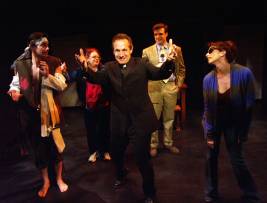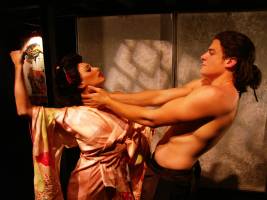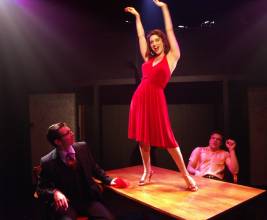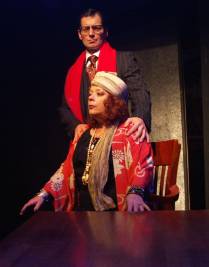
Michael John LaChiusa’s See What I Wanna See is not your grandmother’s musical. There’s no star-struck romantic couple. There are no melodic love songs. There’s not a single dance number. No chorus line. No strings in the orchestra. And not a happy ending in sight.
 No, See What I Wanna See is most definitely not your grandmother’s musical. What it is is a musically complex, intellectually challenging, mostly dramatic, occasionally comedic, entirely compelling chamber musical based on three short stories by early 20th Century Japanese writer Ryūnosuke Akutagawa, also known as the “Father Of The Japanese Short Story.”
No, See What I Wanna See is most definitely not your grandmother’s musical. What it is is a musically complex, intellectually challenging, mostly dramatic, occasionally comedic, entirely compelling chamber musical based on three short stories by early 20th Century Japanese writer Ryūnosuke Akutagawa, also known as the “Father Of The Japanese Short Story.”
The first tale is that of Kesa and Morito, illicit Japanese lovers who each intend to kill the other after a final night of lovemaking. The second is a tale of rape and murder, which each participant (including the ghost of the murder victim) recalls in an entirely different manner. (If this sounds familiar, it’s because the original short story formed the basis for Akira Kurosawa’s film classic Rashomon and its 1964 American adaptation, The Outlaw, starring Paul Newman.) The third centers on a priest who, having lost his faith in God in post-9/11 New York, distributes fliers announcing that “in three weeks, on Tuesday, at 1:00 p.m. sharp, a miracle will occur here in Central Park,” thereby setting off a media frenzy and altering the lives of assorted Manhattanites. Together, the three stories examine the nature of truth and lies, and our perception of both.
Tale #1 (“Kesa & Morito”) is made up of a pair of nearly matching songs which open Acts One and Two, sung in the first act by Kesa and in the second act by Hiroto. Tale #2 makes up the rest of Act One, aka “R. Shomon,” and Tale #3 (“Glory Day”) completes Act Two. The music in Act One is dark and jazzy, becoming a good deal brighter and bouncier following intermission.
 It’s only fitting that See What I Wanna See, which made its off-Broadway debut in 2005, should have its West Coast Premiere at The Blank Theatre Company under the as always superb direction of Daniel Henning, whose previous LaChiusa/The Blank collaborations have included The Wild Party, Hotel C’est L’Amour, and The First Lady Suite.
It’s only fitting that See What I Wanna See, which made its off-Broadway debut in 2005, should have its West Coast Premiere at The Blank Theatre Company under the as always superb direction of Daniel Henning, whose previous LaChiusa/The Blank collaborations have included The Wild Party, Hotel C’est L’Amour, and The First Lady Suite.
LaChuisa’s melodies are invariably among the most intricate, startling, and unpredictable in contemporary American musical theater, and See What I Wanna See is no exception. Though only one or two could possibly be called borderline “hummable” (in the way that Rodgers And Hammerstein or Jerry Herman are hummable), LaChiusa connoisseurs will leave the theater with jazzy musical swatches echoing in their heads, particularly given the performances of See What I Wanna See’s stellar cast (Doug Carpenter, Jason Graae, Lesli Margherita, Perry Ojeda, and Suzan Solomon) and musical director David O’s jazz club-ready five piece band.
Each performer gets a minimum of two diametrically opposed roles to play, and in Carpenter’s and Margherita’s cases, a third thrown in for good measure—and all are roles to die for (a particularly appropriate turn of phrase given the show’s plotlines).
Carpenter has come a long long way since his L.A. musical theater debut a few years ago in Rodgers And Hammerstein’s Cinderella. He follows recent star turns in Life Could Be A Dream and Camelot with his most challenging roles yet. The Act One and Two prologues serve primarily as showcases for Carpenter’s glorious baritone and sculpted physique, but it’s as petty thief Jimmy Mako, with his Mean Streets accent, sexy leer, and tough guy attitude, and as Act Two’s slickly packaged TV reporter that Carpenter gets to strut his stuff as an actor—quite effectively indeed. (Broadway, get ready for Doug!)
Graae is one of those performers who can do it all, as his roles at the Colony in Grand Hotel and The Grand Tour, more recent star turns in Six Dance Lessons In Six Weeks and The 25th Annual Putnam County Spelling Bee, and a memorable hosting gig at last month’s LADCC Awards ceremony attest to. Here the master of the adlib plays it beautifully straight as a jumpy janitor who may be hiding as much as he’s revealing to the police and as a deeply troubled man of faith without faith—and needless to say sings LaChiusa to perfection.
 Margherita, the Yank who won over the Brits in Zorro The Musical (and came away with England’s most prestigious stage award, the Olivier), proves once again that she’s one of our major talents. Dramatically exotic as Kesa, hilariously film noirish (and va-va-voomish) as the first act’s femme fatale in red, and deliciously ditzy as a self-involved, self-medicating actress in “Glory Days.” No one belts better (or sizzles hotter) than Margherita.
Margherita, the Yank who won over the Brits in Zorro The Musical (and came away with England’s most prestigious stage award, the Olivier), proves once again that she’s one of our major talents. Dramatically exotic as Kesa, hilariously film noirish (and va-va-voomish) as the first act’s femme fatale in red, and deliciously ditzy as a self-involved, self-medicating actress in “Glory Days.” No one belts better (or sizzles hotter) than Margherita.
Like Margherita, Ojeda has conquered London’s West End. He’s also starred on Broadway and donned mid-19th Century drag in his hilarious leading lady turn in last year’s Is He Dead? Here, he’s in terrific Robert Mitchum mode as a 1950s gangster and a loopy delight as a CPA turned bum, wearing his torn-to-shreds business suit with unflappable panache. Needless to say, Ojeda matches his costars in vocal prowess.
 Finally, Solomon (The Full Monty’s brassy, sassy scene stealer) does bang-up work as a kooky medium and (with considerable more stage time) as the priest’s earthy atheist/communist Aunt Monica. Solomon’s Aunt Monnie gets two of LaChiusa’s most powerful songs, “The Greatest Practical Joke” and “There Will Be a Miracle,” and she makes them Act Two highlights.
Finally, Solomon (The Full Monty’s brassy, sassy scene stealer) does bang-up work as a kooky medium and (with considerable more stage time) as the priest’s earthy atheist/communist Aunt Monica. Solomon’s Aunt Monnie gets two of LaChiusa’s most powerful songs, “The Greatest Practical Joke” and “There Will Be a Miracle,” and she makes them Act Two highlights.
Under Henning’s sterling direction, the players know when to ham it up a bit and just when to hold back, and the director knows just how to make the best and most visually varied use of the Blank’s very intimate dimensions.
David O and his band fill the Blank with as exciting music as you’re likely to hear this year, yet they never overpower the cast’s gloriously unmiked vocals.
Jeremy Pivnick has created a starkly dramatic lighting design, with film noir shadows and some great smoke-and-light effects. Dana Peterson’s gorgeous costumes and Butch Belo’s great hair and wig design run the gamut from kimonos and kabuki wigs to a sexy red cocktail dress and Rita Hayworth do. Only Ginnie Ann Held’s set design, hardly more than a couple of Asian screens and a police interrogation table and chairs seems a bit more minimalist than needed. Ramon Valdez serves as production stage manager.
Exciting, imaginative, gripping, and musically adventurous—See What I Wanna See is all this and more. With Henning at the helm and a cast and band more than up to the task, this is innovative, modern musical theater at its best.
The Blank 2nd Stage Theatre, 6500 Santa Monica Boulevard, Hollywood.
www.TheBlank.com
–Steven Stanley
April 16, 2010
Photos: Rick Baumgartner


 Since 2007, Steven Stanley's StageSceneLA.com has spotlighted the best in Southern California theater via reviews, interviews, and its annual StageSceneLA Scenies.
Since 2007, Steven Stanley's StageSceneLA.com has spotlighted the best in Southern California theater via reviews, interviews, and its annual StageSceneLA Scenies.







 COPYRIGHT 2024 STEVEN STANLEY :: DESIGN BY
COPYRIGHT 2024 STEVEN STANLEY :: DESIGN BY